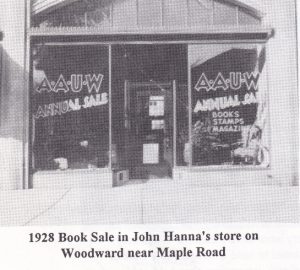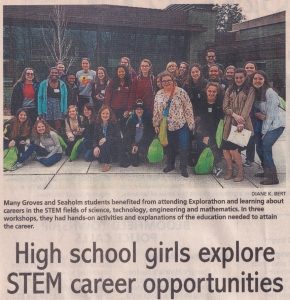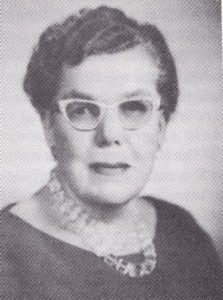100 Years AAUW Birmingham, Mi 1920-2020
In the small village of Birmingham in 1919, there was an awakening of the need for women to unite to continue their intellectual growth. Four of these women met for a church bridge luncheon and, unable to play bridge, began the process of forming an organization for women who wished to continue learning. One of these women was Ruth Edgar Shain. She set about finding other college graduates in the area to reach the 15 required members necessary for national recognition, and on October 16, 1929, the ladies voted to become a branch of the Association of Collegiate Alumnae (ACA). The ACA merged with the Southern Organization of College Women in 1921 to become the American Association of University Women. (AAUW).
The Birmingham Branch of the AAUW convened in Detroit in 1922. Membership grew from 15 charter members representing 7 different colleges to over 700 members in the early 70s. It was discovered that very few girls graduating from public high schools were continuing to college. When financial need was determined to be a problem, they secured permission from the Board of Education and helped to found the Birmingham Student Loan Fund, which later became the Birmingham SCHOLAR Fund. Dances and teas at the Birmingham Country Club and Oakland Hills Country Club in addition to movies at Birmingham High School helped finance this fund.
The first fashion show fund raiser was presented by the J.L.Hudson Co. in 1923.to raise funds for a scholarship. This was the first for the sleepy village of Birmingham, except that a snowstorm on the day of the show could have doomed it. But as show time grew near, horse-drawn buggies
es began arriving and ladies disembarked in their finery which included snow boots. Ruth Shain told of the committee’s plan to advertise for the show. They set up a canvas banner used by a service club, painting over old letters, adding new ones. After all the paint was applied, the banner was so heavy, they had to enlist the aid of the fire department to hang it between two buildings on Woodward. Ruth received a telephone call in the middle of the night that she must come and do something about the “serpent” flailing about in the street. A strong wind had come up, breaking one of the lines holding the banner. The fire dept. was prevailed upon once again; they cut the remaining line, and put the serpent at ease. All of this clamor made great advertising and the show was a social and financial success. Fashion shows continued for many years even to recent times.
The dedicated, dynamic women who founded AAUW organized a group for service and study,
which, from its inception, had vision far beyond the limits of little Birmingham Village. The first program chair, Mary Hall James, organized programs speaking on topics such as the value of a college education “whatever the hardship or obstacles,” “Problems of Divorce Laws,” “The Effect of Science on Civilization.” With extensive reading in our branch, the International Relations Class began in 1922. Ruth Shain, the first branch president, stepped in “temporarily” for 43 years. Her world travels and extensive reading qualified her well for this position. Cosponsored by the League of Women Voters (another group that Ruth helped to found), it was attended by 823 women during these years. Ruth became a delegate to the International Federation of University Women conference in Paris in 1922. The International Relations Class continues as a study group today.

It was 1928 that the first of our 91 annual book sales took place. It was held in John Hanna’s store on Woodward near Maple. The books were all contributed by members and the sale netted $225. Subsequently, many other locations were used: the Wabeek Building, Detroit Edison Office Building, Demery’s Department Store, YMCA and the Masonic Temple on Woodward in Bloomfield Hills. It wasn’t until 1939 that the community was asked to contribute books for the sale. Carl O. Barton in 1948 offered to pay for books selected by local schools and libraries; he was honored by naming a fellowship donation to the Educational Foundation for him. Mr. Barton’s family continued this practice after his death. This idea was expanded to include schools in disadvantaged areas through a Patron, Donor, Friend Fund, created by Jean Walker. Profits from the 69th annual sale topped $17,000, and 55,000 books were recycled in the community to be read again.
Jean Walker was a significant force in AAUW for many years. In addition to the Patron Donor Fund, she co-chaired the Used Book Sale, was president for four years, established the southeast consortium of branches, and chaired the establishment of the present Next Level (previously called Women in Transition.) She knew how to make things happen and wasn’t shy about engaging any and all. An AAUW Research and Projects grant was established in her name by our branch.
 Back to 1944 at the close of the war, Esther Sanders, than branch president, created a plan to bring live theater to the children of the area. The Children’s Theater was formed and lasted until 1981. Many plays were presented in the Birmingham Theater, the Community House, and Groves High School Theater. They began with professional theater companies, but changed to presenting plays acted, directed, and staged by members. They occasionally wrote their own scripts. Members had much fun staging their plays and children were delightfully entertained. The play “Indian Captive” was based on the true story of Mary Jemison, who was captured and lived with the Seneca Tribe of the Iroquois Indians. Jack and the Beanstalk and the Steadfast Tin Soldier were other member productions.
Back to 1944 at the close of the war, Esther Sanders, than branch president, created a plan to bring live theater to the children of the area. The Children’s Theater was formed and lasted until 1981. Many plays were presented in the Birmingham Theater, the Community House, and Groves High School Theater. They began with professional theater companies, but changed to presenting plays acted, directed, and staged by members. They occasionally wrote their own scripts. Members had much fun staging their plays and children were delightfully entertained. The play “Indian Captive” was based on the true story of Mary Jemison, who was captured and lived with the Seneca Tribe of the Iroquois Indians. Jack and the Beanstalk and the Steadfast Tin Soldier were other member productions.

In the early days of AAUW, members had a type of Career Day where they invited professional people to come and speak to high school girls about their careers. In 1970, the members invited high school girls to spend a day with them and to observe careers in their field of interest. Some went to see engineering at Rockwell Standard; others to a veterinary clinic, a bank, Oakland County Court, and a CPA office. After lunch, the girls would return to the library and hear about how to apply for college, and where to seek financial help. A short time later, the branch was invited to reach out to Detroit students and offer the same kind of experience, visiting job sites and speaking with workers in their field of interest. Next the branch began a Carnival of Classes for its own members. This involved up to 30 classes about many different topics. CPR, women’s health, antiques, collectibles, careers for women, preparing oral histories were some of the topics. It was a full day’s workshop with four different classes and a brown bag lunch for each participant. The Carnival of Classes program lasted from 1978 to 1987.
In 1982 a new program called “Yes You Can” was begun with a $1200 grant from the Education Foundation. The project enlisted math and science professionals who presented seminars to middle school girls. The next year it expanded to high school girls in two sessions. The program continues today and is known as “Explorathon.”
To raise funds the Birmingham Branch Boutique was created in 1988. Items made by members were sold every other year until 1994. Diane Bert helped organize sessions to teach members how to make various crafts and art projects.
In summary, over the years, the AAUW has supported philanthropies, scholarships and fellowships with the annual book sale, the Children’s Theater, Puppet Shows, Fashion Shows, Dances, Card Parties, Bake Sales, Community Presentations, the Patron Donor Friend Fund, and more recently, the Lavish Luncheon.

